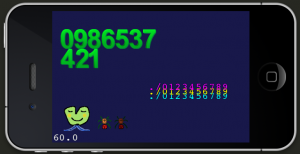KoboldScript Koolness, Part 1
I thought I’d post a very early result of the KoboldScript scene setup. This scene was scripted entirely with KoboldScript with about 50 lines of code:
Below you’ll see the part of the Lua script that created this scene. In fact it’s not so much code as it is defining data, which behind the scenes calls the node functions like setPosition and setColor for you. Continue reading »
Chapter 4 - First Simple Game
After Chapter 3 covered the fundamentals of the cocos2d game engine, this chapter will put to use what you’ve learned. The simple game is all about droping enemies that you have to avoid via accelerometer controls. Sort of like an inverse Doodle Jump. But it’s not just about the gameplay itself, I want the game to be reasonably complete with a main menu, scene transitions, game over and of course audio.
The chapter will be submitted on Friday, July 23rd.
Do you have any suggestions for the game?
What do you think should be in a first cocos2d game? Let me know!
Summary of working on Chapter 3 - Essentials
When I started the chapter I wasn’t really sure about its focus and progress was a little slow. Eventually it clicked and I found myself ending up having written more pages than needed and still having a great number of things left untold. The key was looking at the cocos2d API reference documentation and remembering what it was like when I was a beginner. Sure, every class, method and property is there but for a beginning cocos2d developer the API reference is just a huge list of names. In other words, if your experience was or is anything like mine was, it’s frustrating to work with the API reference.
I ended up writing about the cocos2d engine design and its scene graph first, the remaining 80% of the chapter explain in detail with lots of code samples how to use those darn CCNode classes. All the important ones are covered: CCNode, CCScene, CCLayer, CCSprite, CCLabel, CCMenu, CCMenuItem* as well as the Director, Transitions and Actions. Besides the code samples and how-to I’ve added numerous caveats, common mistakes, best practices and other nodes which are so very much needed to make any documentation complete.
For example, how Layers are best used for grouping other nodes together and of course how to enable touch and accelerometer input by adding the required functions which aren’t mentioned in the API reference since they are part of the iPhone SDK API. There’s also some weird recommendation floating around not to use too many Layers because they’re slow. I can’t find the source but what I did find was that this is only true if the Layers enable touch or accelerometer input, because that’s what costs a lot of performance. So what you don’t want to have is several layers accepting input, otherwise use as many Layers as you need - which shouldn’t be many anyway. And if you do need multiple Layers accepting input, why not just use one master Layer (possibly using a Targeted Touch handler) which forwards the input events appropriately to the other Layers?













